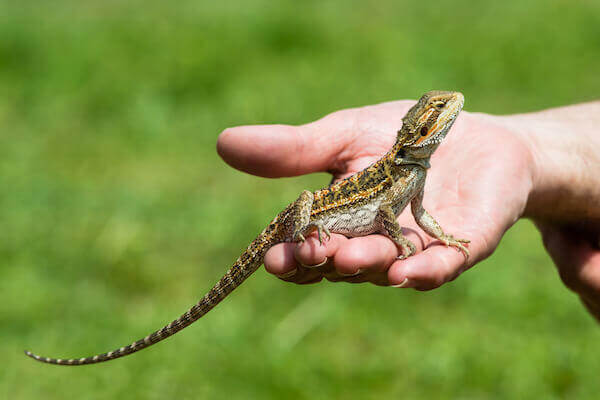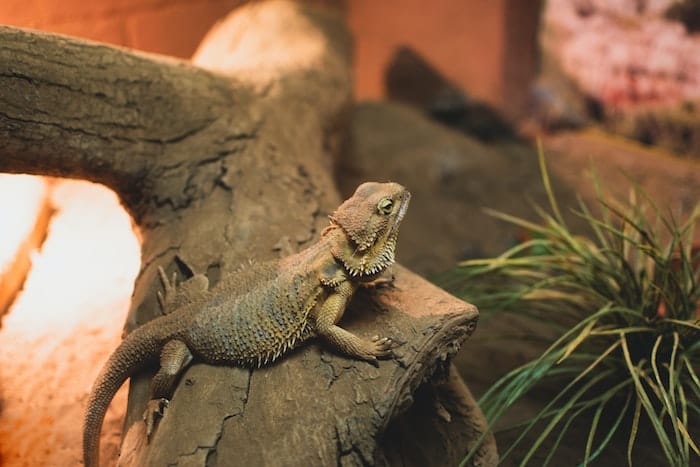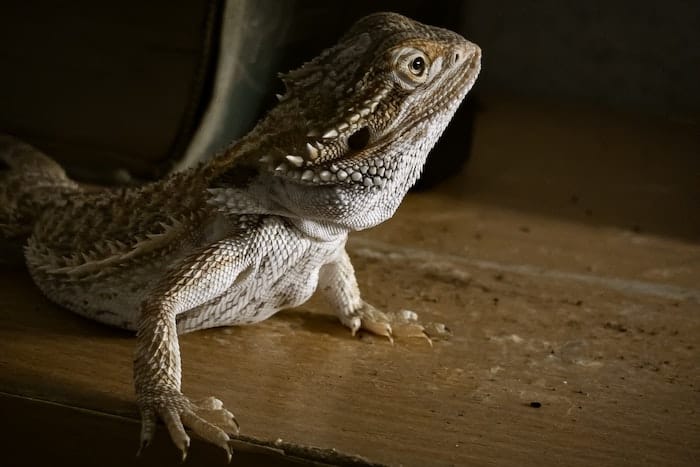Although bearded dragons tend to be a low-maintenance pet once they’re properly settled, they still need a good home setup to keep them happy and healthy. When welcoming a bearded dragon into your family it’s important to consider what size tank is best for your bearded dragon as well as how much space is available in your home. Here’s what we’ve learned about choosing the best tank size for a bearded dragon.
What Size of Tank to Consider
Tank size for baby bearded dragons
Baby bearded dragons less than 10 inches in length need a tank size of between 20-40 gallons. Putting your baby dragon in a larger tank can actually make their life harder, as they may struggle to catch any live food that you put in there
The 40 Gallon Bearded Dragon Tank
When we walked out of Petco with our first bearded dragon, we didn’t have a clue about what we were doing. We had bought everything the salesperson told us we needed: a 40-gallon bearded dragon “kit” that included a bunch of stuff we soon discovered we didn’t actually need… as well as a couple of things that could be downright harmful to our new beardie.
The 70 Gallon Bearded Dragon Tank
This is a common tank size for upgrading your bearded dragon’s home. Estimated measurements are usually 48″x18″x18″ depending on the manufacturer. Since it’s a foot longer than the 40 gallon tank, you have more room to work on controlling the temperature in each side of the tank. Beardies need one side of their tank to be cooler than the other, so they can easily cool down if they’re getting too warm while basking or relaxing under their lamps.
The 120 Gallon Bearded Dragon Tank
The 120-gallon bearded dragon tank size is considered to be ideal for giving your beardie the ultimate amount of space to stretch out. Generally, this size tank size measures 4’x 2’x 2′. Many bearded dragons thrive when given ample room to run, jump, and climb. These enclosures are overall three times larger than 40 gallon tanks!
Tank height and width matters
You might think that you’ve selected the right size tank in terms of gallons, but make sure it’s high and wide enough as well. We recommend a tank with a height and width of 24 inches. Taller tanks allow for your bearded dragon to move toward or away from the heat source at the top, so if you provide plenty of levels for them to choose from, they can find the perfect spot!
Can two bearded dragons share a tank together?
No, it’s best not to house two bearded dragons together. They are solitary creatures and co-habitation often does not end well. There have been many instances of bearded dragons fighting with each other, injuring one another, and having considerable stress when sharing a tank. The risk is just too great.
What type of tank to choose?
Whatever material you decide on, there are usually two different types of reptile tanks: top opening and side opening. Top-opening tanks are like fish aquariums, so they’re readily available and come in plenty of different materials. One issue with this type of tank is that you need to reach into the tank from above if you want to take your beardie out.
Depending on the personality of your bearded dragon, this can spook them, as seeing something bearing down on them from abovez can feel like a predator attack in the wild.
Enclosure Material
Now let’s discuss what is the best material to use for your bearded dragon tank. There are definitely plenty to choose from, and if you start looking up options online you may feel overwhelmed. If you aren’t going to build your own bearded dragon tank DIY style, chances are you’ll buy one online or at a pet store. Here are some of the basic reptile tanks that you can choose from:
- Glass
A popular option, reptile glass terrariums are sturdy, widely available, and usually come with a screen lid that improves airflow and helps regulate the low humidity dragons need. You can also get a front-opening glass terrarium that makes it easy to access your pet and clean the tank. On the downside, glass is a poor heat insulator, so you’ll have to check the temperature regularly to make sure it’s not too cold. This isn’t too difficult to commit to especially if you have a thermometer gun.
- PVC
Plastic is another option. It’s quite lightweight, and there are generally a lot of colors you can choose from. PVC enclosures are often designed for stacking, which is ideal if you plan on adopting more than one dragon. One common issue with PVC terrariums is poor airflow, so you have to be a little more vigilant with the humidity levels than with other cages. This shouldn’t be too difficult if you get into the habit of checking the humidity on a regular basis.
- Screen
In your search for a terrarium you may see some that have walls made from wire screens. These are extremely dangerous for bearded dragons. In addition to the obvious heating issue, screen cages can injure bearded dragons. Of course, glass terrariums with a screen lid are a different story, because the bearded dragon will likely not be able to reach the screen lid. We cannot recommend using a screen-walled terrarium.
Location in your home
Some first-time Dragon Keepers might not realize how important it is to determine where you will put your bearded dragon ahead of time. It will save you a lot of stress if you clear a place and get everything set up before you bring your new reptile friend home. Here are some guidelines in deciding where to keep your dragon’s new home:
- Do not place your dragon in direct sunlight. This can actually kill your bearded dragon. Although sunlight is good for them in the wild, in a domestic environment it quickly becomes deadly. The heat from the sun easily becomes trapped in the terrarium—especially if it’s glass—and the temperature will become life-threatening to your dragon. A good quality reptile UVB lamp is the best way to provide the heat and light they need.
- Know ahead of time how much room you need. If you’ve never owned a reptile before, you may not realize how big the tank really is, and the amount of space it takes up may surprise you. The standard size 40-gallon tank is 36 inches long by 18 inches wide by 18 inches deep. You will need a sturdy surface to set it on, so make sure you measure in advance.
- At the same time, make sure you can access the tank easily. You will need to clean the tank, take your dragon out for playtime and baths, and give your dragon lots of love, so it’s best to make sure you can easily get to the tank.
- Keep the tank in a place that is light during the day and dark at night. While you will be providing reptile UVB light 12 hours a day for your dragon, they have trouble sleeping if lights are left on at night, so it’s best to place them in an area that is quiet and dark at night. This is especially important during brumation if your bearded dragon ends up going through that process.
Related Reading



